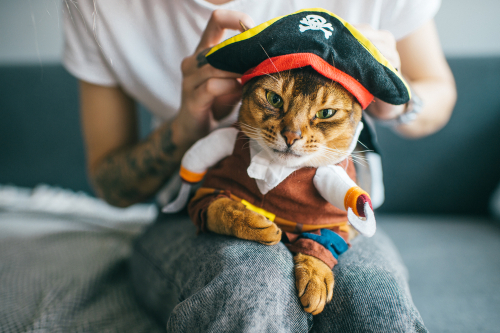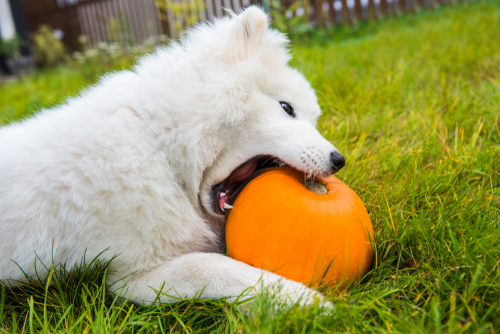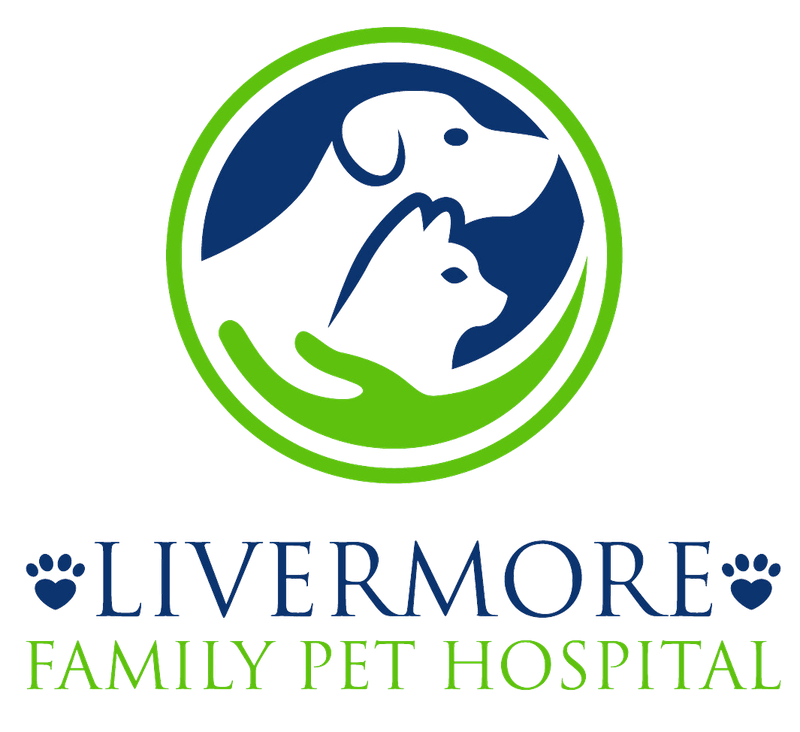
If you’re a Halloween fanatic—and also a doting pet parent—you may get chills up your spine as the days become shorter, and the leaves start to change. Planning Halloween costumes, decorations, and parties can be oodles of fun, but these frightening festivities may also pose certain safety concerns for your furry friends. At Livermore Family Pet Hospital, your pet’s safety is our top concern. Learn how to keep your companions out of harm’s way, while still enjoying this spooktacular night.
#1: Chocolate isn’t the only danger lurking in your Halloween candy
As a pet owner, you likely know that chocolate is a big no-no when it comes to dogs and cats. Ingredients in chocolate, such as theobromine and caffeine, can lead to vomiting, diarrhea, heart failure, and neurological problems, like seizures in dogs, who cannot metabolize these substances as well as people.
While chocolate still tops the list of dangerous Halloween candies, other ingredients can be equally hazardous. Xylitol, a popular sugar substitute commonly found in toothpaste and peanut butter, is also frequently found in gum, sugar-free candies, and baked goods. While harmless for humans, xylitol in only small doses can cause dangerously low blood sugar levels if ingested by pets. Other potentially hazardous substances that may be hiding in your Halloween treats include macadamia nuts, raisins, and plastic candy wrappers, which could become lodged in the intestines. Not to mention—high-fat candies can cause pancreatitis in vulnerable pets, too.
#2: Many pets aren’t big fans of Halloween
Many of us adore this ghoulish holiday, yet most pets don’t understand the thrill of frights, lights, and costumes. In fact, many may bolt at the sight of a freaky mask, or a loud “Boo!” Keep this in mind if your pet isn’t a fan of strangers, startling noises, or the doorbell. You may want to consider creating a refuge where less-than-elated pets can relax, while you and the family engage in the festivities. Choose a room in a quiet area of your home complete with a cozy bed, a few toys or puzzles, and maybe some relaxing music or white noise, to drown out any Halloween shrills or screams.
#3: Not all costumes are safe for pets
From hot dogs, to tacos, to pumpkins, pet stores are filled with fun, creative outfits for pets this time of year. But, you shouldn’t choose one for your pet simply because they are available. Before deciding on a costume for your furry friend, first ensure that they will tolerate the outfit. If your pet isn’t big on wearing clothes, you may want to forego the dress-up this year. If your pet will tolerate a costume, the outfit absolutely must not hinder breathing, eyesight, or hearing, or have any embellishments that they may choke on, or entangle themselves. Choosing a costume for your pet that is simple, comfortable, and easily taken on and off is key.
#4. Seemingly harmless Halloween decor may not be pet-friendly
String lights, jack-o’-lanterns, and festive garlands may make your spooky spirit sing, but for curious pets, they could pose problems. Decorative strings and garlands are enticing to feline friends, who may mistake them for a fun, new toy, which can lead to entrapment, strangulation, or electrocution if string lights are involved. Nothing says Halloween like candles and jack-o’-lanterns, but rambunctious pets may knock these over, potentially starting a house fire. Keep your home festive but safe. Place garlands only where cats cannot access them, and use lit pumpkins and string lights only outdoors.
#5. You may not eat your pumpkins, but your pets might

That’s right—some pets, dogs, in particular, may find raw pumpkin a rare treat. Pumpkin is not toxic to pets like chocolate or xylitol, but can lead to vomiting, diarrhea, or an intestinal blockage, if your pet devours large amounts. If your furry friend is particularly mischievous, you should keep all pumpkins outdoors where pets cannot access them—especially after they’ve been carved.
Keeping Halloween safe for your pets doesn’t mean you have to spoil all their fun. Here are a few ways to keep things festive, yet risk-free:
- Keep the treat bowl stashed away from pets.
- Opt to hand out non-toxic treats, such as pretzels, chips, or granola bars.
- Whip up some fun Halloween treats—for your pets only.
- Ensure pets are microchipped or have up-to-date identification tags, in case they escape.
- Forego taking pets trick-or-treating, or to Halloween parties.
At Livermore Family Pet Hospital, we love Halloween—and your pets. If you have questions about toxic foods, appropriate costumes, or any other Halloween-related inquiries, don’t hesitate to contact us.

